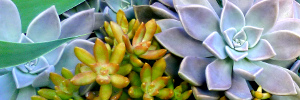
Related Topics: |
|
Information about plants & gardens for Brisbane & Qld |

|
|||
| |||
Succulents, with their fleshy leaves or stems, are an easily-recognised group of xeriphytes (or xerophytes) which are plants adapted to withstand prolonged periods with little water. This group has become very popular recently as many parts of the world face increasing watering restrictions and declining gardening skills.
Their interesting "architectural" forms work well with contemporary building design. However, they could be very usefully incorporated into a more traditional garden if most of the succulents used are of the softer and prettier types and mixed in with other plants. Some bold types can be blended with drought tolerant palms, strelitzia and such for a waterwise tropical landscape.
Note, however, that they do have a lot of weed potential, reproducing readily from small pieces and surviving harsh conditions. Some are already recognised as weeds.
Backyard growers on the Sunshine Coast have had over 1,000 banned plants (mostly cacti) seized and destroyed. "Our staff, together with Sunshine Coast Regional Council officers have been on the lookout for people selling illegal plants either online or through local markets," said Biosecurity Queensland Operations Manager Rob Cobon. If you're aware of someone growing or selling illegal plants, you can alert Biosecurity Queensland on 13 25 23. Source: Biosecurity Queensland and Sunshine Coast Council target illegal weeds in backyard nurseries. (January, 2020)
Various other succulents below:
Genomic anaysis suggests that while the Cactus family probably emerged some 35 million years ago, rapid diversification did not occur until between 5 and 10 million years ago. This coincides with major periods of speciation in other succulents around the world, suggesting a major change in global climate at that time. The scientists think that a drop in temperature (indicated by other studies) led to reduced rainfall. It is also possible that a drop in atmospheric CO2 may have also given the succulents a competitive advantage. Tropical grasses with the C4 mode of photosynthesis also expanded at this time. Source: Succulent plants waited for cool, dry Earth to make their mark (May 2011)
All Australians, especially anyone who grows or handles plants, should be aware of proposals from the federal government to expand the list of species to be banned or regulated due to alleged drug dangers. A variety of Australian natives and common garden exotics could potentially be banned, in addition to many cactus species. The website gardenfreedom.com provides more information on this issue, including how you can have your say.
|
© Calyx Horticultural Services ABN 38 518 961 623
|